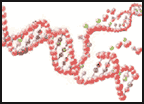Research in the Sciences | 1951 | April-May 1953 | June 6-11, 1953 | June 13, 1953 | 1954 | 1957 | 1962 | 1969 | 2001 | Recap
« previous Page 3 of 11 next »
Breakthrough: The Double Helix
Two Years Later
April-May 1953
Crick and Watson publish a short article announcing their conclusion that the structure of the DNA molecule is a double spiral. They submit the announcement to the general scientific British journal Nature, knowing it will be published quickly.
Molecular Structure of Nucleic Acids
We wish to suggest a structure for the salt of deoxyribose nucleic acid (D.N.A.).Watson, J.D., & Crick, F.H.C. (1953).
Nature, 171, 737-738.
Although the article allows Crick and Watson to officially stake their claim to the discovery, it does not come as a surprise to the other scientists working on the same problem. Informal communication — also known as the "invisible college" — spreads the news. Crick and Watson tell Wilkins and Franklin about their discovery, and Pauling hears about it from another colleague at Cal Tech.
In a process known as peer review, the editors of Nature send pre-publication drafts of the article to Wilkins, Franklin, and other scientists for review and comments.

Image from (link will open in a new window) DOE Human Genome Program website
May 1953
Crick and Watson follow up with another Nature article a month later:
Genetical Implications of the Structure of Deoxyribonucleic Acid
Until now, however, no evidence has been presented to show how [DNA] might carry out the essential operation required of a genetic material, that of exact self-duplication.Watson, J.D., and Crick, F.H.C. (1953).
Nature, 171, 964-967.
| General Scientific Journal Article Characteristics | |
| AUDIENCE: | Students, professors, or researchers; assumes some knowledge of science but not expertise in any one area. |
| AUTHOR: | Professors or research scientists |
| TIMELINESS: | Announcements like the Nature articles above can be published within a month or two of submission; longer research articles take a year or more from submission to publication. |
| CONTENT: | Report major findings in all areas of the sciences. Articles focus on a specific research question; back up information with footnotes and/or reference lists citing earlier research; may include graphs, tables, and pictures to document findings. |
« previous Page 3 of 11 next »
